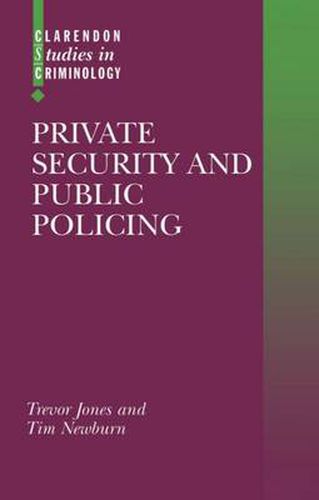Readings Newsletter
Become a Readings Member to make your shopping experience even easier.
Sign in or sign up for free!
You’re not far away from qualifying for FREE standard shipping within Australia
You’ve qualified for FREE standard shipping within Australia
The cart is loading…






In this first major empirical study of its kind, the authors examine the growth of ‘private’ policing and its relationship with, and implications for, the public police service. Beginning with a critique of the sociology of policing, the authors then provide a detailed analysis of the concepts of public and private, and examine the boundaries between different forms of policing. Using data from the first ever survey of the private security sector in Britain, the authors provide estimates of the numbers of employees and firms in the industry; the range of services and products offered; and the attitudes of those at senior levels in private security organizations. Competiting theoretical explanations for the growth of private policing are then considered. The book then examines policing at the local level. Using a case study of the London Borough of Wandsworth, the authors examine the range of individuals and organizations involved in policing on the ground. They describe and analyse the activities of the full range of ‘policing’ bodies, including the public police force, investigatory and regulatory agencies attached to national and local government, and private security organizations. Using this analysis, the authors offer a thorough reconceptualization of what is meant by ‘policing’ in the late modern era, and consider the implications of this for the public police service and for the future of policing generally.
$9.00 standard shipping within Australia
FREE standard shipping within Australia for orders over $100.00
Express & International shipping calculated at checkout
In this first major empirical study of its kind, the authors examine the growth of ‘private’ policing and its relationship with, and implications for, the public police service. Beginning with a critique of the sociology of policing, the authors then provide a detailed analysis of the concepts of public and private, and examine the boundaries between different forms of policing. Using data from the first ever survey of the private security sector in Britain, the authors provide estimates of the numbers of employees and firms in the industry; the range of services and products offered; and the attitudes of those at senior levels in private security organizations. Competiting theoretical explanations for the growth of private policing are then considered. The book then examines policing at the local level. Using a case study of the London Borough of Wandsworth, the authors examine the range of individuals and organizations involved in policing on the ground. They describe and analyse the activities of the full range of ‘policing’ bodies, including the public police force, investigatory and regulatory agencies attached to national and local government, and private security organizations. Using this analysis, the authors offer a thorough reconceptualization of what is meant by ‘policing’ in the late modern era, and consider the implications of this for the public police service and for the future of policing generally.